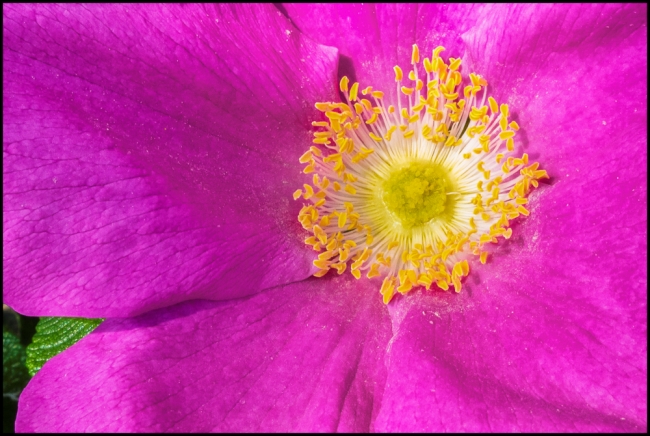Certainly a Wild Rose, but I’m not entirely sure which one. I suspect it’s a Carolina Rose described by the USDA Forest Service as follows:
Carolina Rose is a member of the Rosaceae (Rose) family. The rose family includes well-known species as diverse as garden roses, strawberries, apples, peaches, and blackberries. Roses typically have leaves with 3 to 9 leaflets, stems with hooked prickles (“thorns”) and bristles, and upright or arching stems (canes). Flowers have a base petal number of five, with many cultivated roses showing a hundred or more petals.
Carolina rose usually has five or seven leaflets, but may have three, on leaf that is 10 to 15 centimeters (4 to 6 inches) long by 6 to 8 centimeters (2.4 to 3.2 inches) wide. The stems are upright, grayish on new growth, and brown on older branches. The plants spread by rhizome/root shoots and form small to large thickets from 0.5 to 1 m (18 to 40 inches) high. Flowers on Carolina rose are about 6 to 8 centimeters (2.5 to 3 inches) across, with five light pink petals and a yellow center. Flowers are generally borne singly on the ends of the current year’s growth. The sepals have glandular hairs on them (see photo). Prickles are few to numerous on the stem.
Carolina rose is a species of varied habitat occurring in dry soils in and at the edge of prairies, woodlands, and savannas, in fencerows and thickets, in upland forest, and dunes. It is found from Maine south to Florida, west to Texas, north to Nebraska, Iowa, and Minnesota. It also occurs in Canada from Ontario east to Nova Scotia. This rose can be confused with Virginia rose (R. virginiana). Virginia rose is less heavily armed, has leaves with seven to nine leaflets, and usually bears flowers on second or third year canes.
The species can be cultivated and is frequently sold by nurseries. It needs full sun to moderate shade. It is drought tolerant, but does best with regular watering in well-drained soils. The fruit or hip, rather tart, is edible, but is full of seeds and irritating hairs so should be carefully cleaned before consumption. Numerous species of bees visit this plant.
Taken with a Sony RX-100 M3.

